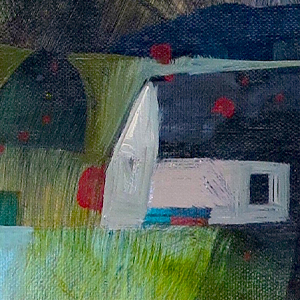
Employing Virtue
A Door to the Interior Life
Poetry as a Practice of Leisure
Karen E. Bohlin
Artwork: “The Ants Go Marching” by Justin Wheatley © 2018
This essay is written for fellow educators—especially those of us charged with forming future doctors, teachers, engineers, and professionals whose work will shape the well-being and flourishing of others.
We teach, advise, publish, serve on committees, manage clinical partnerships, and try to remain human in the process. Much of this work takes place in institutions shaped by metrics and motion, where our value is often measured by speed or output. But we are not machines. And if we are to sustain the presence, discernment, and mentoring our students need—not to mention find meaning in our own lives—we must recover something many of us have lost, access to our interior lives.
By this, I don’t mean anything esoteric. The interior life is the space where we reflect, imagine, create, and discern. It is the seat of our freedom and the root of our authenticity, where our unfettered and truest self resides. Whether or not we consider ourselves spiritual, it is here that joy and creativity take shape. And it is here, too, that the possibility of leisure, rightly understood, begins.
Poetry is one way in. It opens a door to the interior life—one we may not have known we needed until we step through it.
This essay makes the case that poetry is not a luxury, nor the exclusive domain of literature students with time to spare. It is a vital contemplative practice—one that can nourish our interior lives, form the moral imagination, and help us return to our work with greater clarity and care.
Josef Pieper, in Leisure: The Basis of Culture, reminds us that leisure is not just time off. It is, in his words, “a mental and spiritual attitude . . . a condition of the soul.”1 It is a kind of interior openness to truth and beauty that resists the totalizing forces of work. This kind of leisure, he argues, is the foundation of learning, culture, and wisdom.
Poetry cultivates this leisure. It draws us into stillness. It sharpens attention. It deepens our capacity to feel. These are not incidental effects. They are, I suggest, quiet necessities for a flourishing interior life.
Long before poetry became a subject of study, it was a way of being human. It predates literacy. Its rhythm, meter, and form made it possible to remember and retell long before anything was written down. Homer, Sophocles, Virgil, Dante, Shakespeare, our earliest and most enduring storytellers wrote in verse. Their words were spoken aloud, repeated, passed from one voice to the next. The epic tradition, the Psalms, the tragedies and odes of ancient Greece: these remind us that poetry has long helped people pass on what matters.
The word poetry, or poiesis, from the Greek ποίησις, means “to make”—to create something meaningful from breath and words. Aristotle understood this well. In his Poetics, he defines poetry as a form of mimesis, or imitation, whose medium includes rhythm, words, and melody. For him, these formal elements aren’t decorative; they shape how a listener experiences the poem, evoking emotion and insight in ways that exposition cannot.
Poetry continues to thrive in the public square: we spot Yeats posted in the London Underground and integrate poetry in the training of physicians, through initiatives like Harvard Medical School’s Arts & Humanities Initiative, to help future doctors attend more closely to the individual stories and emotions of those in their care. The Favorite Poem Project, with participants from all fifty U.S. states, is a national archive in which Americans—from firefighters to teachers and veterans—read aloud the poems that have become part of their personal memory. These are not merely recitations, but reflections on how a poem anchors, consoles, or animates them in ways that are deeply human. It is in these filmed moments—intimate yet public accounts from the most unexpected voices—that we glimpse how poetry opens a doorway to the interior life.
Poetry still speaks. And for those of us who spend our days forming the intellectual and professional lives of others, it may help us refine our capacity to listen. This essay draws on my own experience in teaching and professional education, including with those initially reluctant to read poetry at all. Across settings, I have seen what poetry can do. In what follows, I explore three ways poetry helps us reclaim our interior life and recover the kind of leisure that helps us become more fully human.
Stillness: Countering Restlessness
One poem. That’s all it took to change the atmosphere of the classroom.
Twenty-three high school seniors had arrived, preoccupied and taut shoulders hunched under the weight of college essays, practice schedules, part-time jobs, and friendship tensions. Their bodies were restless. Their minds scattered. I watched the strain on their faces as they took their seats—not quite present, not quite still.
And then I read a poem. Once. Then again.
The poem was Sarah de Nordwall’s “I Put an Orchid in My Room.” It begins:
I put an orchid in my room
When the room was a total mess.
The orchid was so beautiful
She had the power to bless.
The first time, they were quiet. The second time, I noticed a change. Their shoulders softened. Their breathing slowed. A few picked up pencils and began to sketch. Others simply stared ahead. One or two closed their eyes.
We paused on the final image:
Disorder left and chaos fled.
Her loveliness was power.2
I asked, “How does this poem make you feel?” “Peace,” one student said. Another added, “Calm.” A third: “Simple joy.”
The conversation that followed was light and easy. There was laughter, and then stillness again, the kind that doesn’t need to be filled. We carried on reading and discussing other poems. At the end of class, a few students lingered, in no hurry to leave. I watched them walk out differently—unhurried, at ease, as though something within had quietly realigned.
What had happened was subtle, but real. The pace slowed. Their presence softened. The poem had made space. And in that kind of space, stillness becomes possible. Pieper urged true leisure is “an attitude of non-activity, of inward calm, of silence; it means not being ‘busy,’ but letting things happen.” The kind of stillness poetry cultivates is not passivity. It is readiness. A way of being receptive to what might emerge. And that, I have come to see, is a condition for the interior life to take root.
Attention: Learning to Notice
I didn’t come to poetry through a childhood love of verse. I came to it by accident. As someone who liked things that could be measured and seen, I began college thinking I would major in biology. Then I signed up for a course on Romantic poetry at Boston College. The professor was John Mahoney: tall, commanding, wild eyebrows, a sonorous voice, and the habit of pacing the front of the room while reciting lines aloud.
One day, he was reading from Wordsworth’s “She Dwelt among the Untrodden Ways.” Lucy—this quiet country girl we barely know, who lives and dies in a handful of lines—is described in an image I’ve never forgotten:
A violet by a mossy stone,
Half hidden from the eye;
He repeated the lines, then stopped mid-pace and smiled. There was something curiously resonant in the way he let them settle in the room—unhurried, unexplained.
That phrase, “a violet by a mossy stone,” unlocked something. It was simple, unassuming. Beauty hidden. Half-shadowed. Easily missed. And somehow, that made it more moving. More real.
It wasn’t just that I found the image beautiful. It was that I had noticed it. And in noticing, something in me had shifted. I began to see how much I overlooked. The poem opened up another way of knowing, intuitive, sensory, quiet. A kind of seeing that doesn’t just gather information but is attuned.
That image has stayed with me. I think of it on walks, especially in the woods, when I catch sight of something small yet quietly radiant. That one line captures what poetry did, even then: it began to train my attention. It changed what I saw—and what I looked for—not only in nature, but in people, and in the ordinary rhythms of my life. It taught me to look for the extraordinary in the ordinary.
Before that course, I thought of attention as neutral—a matter of focus or acuity. Poetry showed me attention could be formative. It could teach me to perceive differently. To notice not what stands out, but what nearly escapes. Good poets do this with remarkable economy. They distill human experience into something so concentrated it can stir memory, awaken curiosity, even offer a momentary balm in the middle of a demanding day. Their imagery doesn’t embellish; it reveals. And in that moment of recognition—of seeing differently—something shifts.
“She Dwelt among the Untrodden Ways” ends with another quiet jolt:
She lived unknown, and few could
know When Lucy ceased to be;
But she is in her grave, and, oh,
The difference to me!
The loss is nearly invisible to the world. But not to the speaker. That final line “the difference to me” is as stark as it is restrained. It names what only attention can hold: the felt significance of what we might otherwise miss.
For those of us who live by the relentless demands of meetings, deadlines, and syllabi, this kind of attention is not incidental. It is a quiet form of restoration. When we allow poetry to interrupt our pace, we begin to notice again—carefully, humanly. And in that noticing, we begin to reclaim the interior life that so much of our work-driven culture pushes to the margins.
Feeling: Deepening Our Way of Knowing
Langston Hughes’ “Mother to Son” begins simply: “Life for me ain’t been no crystal stair.”
The line is plainspoken, but it lands with weight. The mother, the speaker in the poem, is worn, fierce, and full of love. She doesn’t soften life’s edges, but she doesn’t give up either. She urges her son to keep climbing—even when the stairs are splintered, even when there’s no light.
Some years ago, in a workshop I led for high school faculty, I asked teachers across departments to read the poem aloud in pairs. Then I read it again, slowly, for the whole group.
When we reached the refrain, “Life for me ain’t been no crystal stair,” I asked them: “What do you hear in her voice?” The responses came slowly at first, then gathered momentum. One teacher spoke about the mother’s grit. Another heard fatigue. Someone mentioned love—the kind that is protective, unyielding. A math teacher sat quietly for a while, then said, “This is the conversation I never had with my son. And now I want to.”
It wasn’t analysis. It was recognition—raw, reflective, and unfinished.
Around the same time, I came across an account from a youth detention center in Tacoma, Washington, where educator Margaret Ross ran a book club. In a New York Times Learning Network article published on November 7, 2017, Ross described how, near Christmas in 2013, she read “Mother to Son” aloud to a group of ten young men. One of them, recently incarcerated because, as he put it, “my mother didn’t want me,” broke down mid-poem—head on the table, shoulders trembling.
A week later, on December 18, the New York Times published a column by Charles Blow titled “Defining Moments and Crystal Stairs.” Blow quoted the same poem, writing, “That poem helped change my life when I was younger. It steadied me when the world was rocky.” Ross brought copies of the article to the next meeting and asked who would like one. Every hand went up.
At their next session, the young man who had wept asked if he could read the poem aloud. This time, his voice was steady. No one looked away.
What stayed with me in both moments—the faculty workshop and Ross’s detention center book club—was how poetry made space for three dimensions of feeling:
Sensory: the texture of “splinters” and “tacks,” the boards “torn up.”
Emotional: the ache of abandonment, the force of a mother’s love, the resilience born of hardship.
Empathic: the recognition of another’s story as worthy of attention, an opening into what someone else carries, whether a stranger or someone seated beside you.
Poetry doesn’t argue or persuade. It gives us language when language fails. It helps us feel what we didn’t know how to name and imagine how others might feel, too. As one of my mentors once put it “Poetry helps us to say what we cannot say for ourselves.”
A Quiet Necessity
We began with a question many of us carry quietly: How do we stay human and reclaim our interior lives when the pace of professional work can leave us treading water, with little space for reflection?
Poetry, I’ve suggested, is one way in. It nurtures the stillness, attention, and sensitivity to feeling that make interior life possible. These are not optional states. They are quiet necessities for anyone seeking to live well and lead wisely. Without them, we run dry. With them, we begin to recover our capacity for discernment, empathy, and practical wisdom.
That matters, especially in moments of strain, when we’re over-focused on solving, fixing, producing. When our instinct is to power through, we need practices that help us pause. Poetry invites that pause. It slows the pace, opens a space, and often changes the tenor of the room—sometimes literally.
I’ve opened executive retreats and professional seminars with poems like these—not to soften the room, but to ground it. They summon us, helping us rediscover the heart of our work and of one another. I’ve gifted John O’Donohue’s “For One Who is Exhausted” to colleagues and family members teetering on the edge of burnout, when recovery felt just out of reach. These poems don’t fix problems. But they do something else: they bring us back into contact with our interior lives and the deep reserves that restore our strength.
So here is what I offer—not a prescription, but an invitation. Any one of the following poems may move, steady, or delight you. But please—don’t add them to your task list. Don’t treat them as a productivity tool or a neuro hack. This is not about self-optimization. This is about a return to what it means to be human. Take them one at a time. Read them slowly. Aloud. More than once.
If you’re caring for an aging parent or facing a diagnosis that will change a loved one’s life, pick up “Matinee” by Patrick Phillips. Let it walk you into the ache and quiet wisdom of enduring love.
If you’re in a liminal space—navigating change, uncertainty, or loss—take up Wendell Berry’s “The Peace of Wild Things.” Let each image and stanza steady your breath and help you find your footing again.
If you miss the wonder of first love, revisit Gary Soto’s “Oranges.” Let its winsomeness rekindle your sense of romance.
If you’re holding hope for someone who is incarcerated or struggling, turn to Jimmy Santiago Baca’s “Cloudy Day.”
These poems won’t fix what’s broken. But they might steady you. They might open a door to your interior life. Poetry, as a contemplative practice, is a form of leisure rightly understood—a quiet, sometimes forgotten door to the space of interior freedom and joy we so often neglect.
Notes
- Josef Pieper, Leisure: The Basis of Culture (Ignatius Press, 2009), p. 46
- Poem excerpted from Sarah de Nordwall, “I Put an Orchid in My Room,” in 50 Poems for My 50th (2015). Used with appreciation.
 Karen E. Bohlin is author of Teaching Character Education Through Literature and “The Power of Art to Shape our Ability to See: A Phenomenological Reflection on Rembrandt” in Toward an Ethics of the Imagination (Routledge, 2025 at press) and “Educating the Heart: Why Poetry Matters” in Educating Character Through the Arts (Routledge, 2023).
Karen E. Bohlin is author of Teaching Character Education Through Literature and “The Power of Art to Shape our Ability to See: A Phenomenological Reflection on Rembrandt” in Toward an Ethics of the Imagination (Routledge, 2025 at press) and “Educating the Heart: Why Poetry Matters” in Educating Character Through the Arts (Routledge, 2023).
Fall 2025
Part I: Employing Virtue
Chris Higgins
Anna Bonta Moreland
Karen E. Bohlin
Zena Hitz
Interlude: Meaningful Employment
Michelle Weise
Part II: Employing Vocation
MORE

















